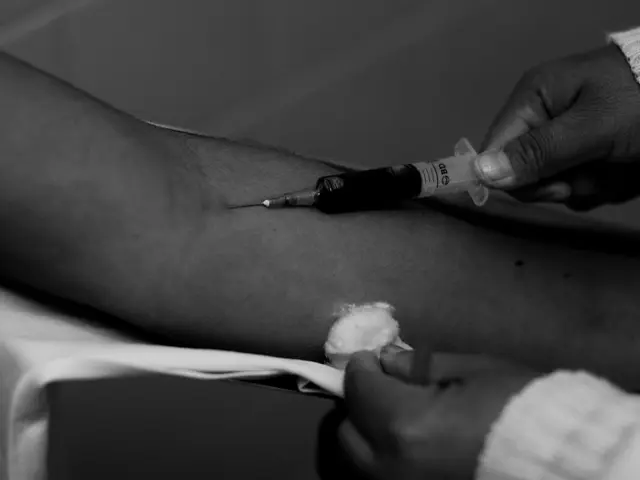Medical Imaging Test: Details on Usage, Process, Price, Potential Complications, and Safety
Angiograms, a vital diagnostic and therapeutic tool in cardiovascular care, provide clear visualisation of the heart's blood vessels and offer immediate intervention capabilities. These procedures are essential in the diagnosis and treatment of various cardiovascular diseases, including coronary artery disease (CAD) and peripheral artery disease.
Primarily used to detect abnormalities such as narrowed or blocked arteries, aneurysms, blood clots, and vascular malformations, angiograms play a crucial role in assessing the heart, brain, and other organs. They are particularly valuable in evaluating arteries in the heart, brain, and other critical areas of the body.
The procedure typically involves the insertion of a catheter through the groin into an artery, followed by the injection of a radiopaque contrast dye and X-ray imaging to visualise blood flow and arterial condition. The process usually takes around three hours, requiring the patient to fast beforehand.
While angiograms offer numerous benefits, they carry some risks. These include radiation exposure, allergic reactions to the contrast dye, potential kidney function impairment, and procedure-related complications such as bleeding or infection at the catheter insertion site. Rare cases of arterial damage or embolism may also occur.
Recovery tips include drinking plenty of water, keeping the wound clean and dry, and avoiding taking baths, using hot tubs, or swimming while the wound heals. After an angiogram, a person will need to rest and avoid driving, strenuous physical activity, baths, hot tubs, or swimming until the wound heals.
In conclusion, angiograms are a critical diagnostic and therapeutic tool in cardiovascular care, offering clear visualisation and immediate intervention capabilities, but they carry some risks related to radiation and contrast dye use that must be carefully managed. For those with pre-existing conditions or allergies, special precautions may be necessary.
References:
[1] Mayo Clinic. (2021). Angiogram. Retrieved from https://www.mayoclinic.org/tests-procedures/angiogram/about/pac-20394803
[2] American Heart Association. (2021). Cardiac Catheterization. Retrieved from https://www.heart.org/en/health-topics/heart-attack/understanding-angioplasty-and-stenting/cardiac-catheterization
[3] Cleveland Clinic. (2021). Angiogram. Retrieved from https://my.clevelandclinic.org/health/tests/12946-angiogram
[4] National Heart, Lung, and Blood Institute. (2021). Cardiac Catheterization. Retrieved from https://www.nhlbi.nih.gov/health-topics/cardiac-catheterization
[5] Johns Hopkins Medicine. (2021). Angiogram. Retrieved from https://www.hopkinsmedicine.org/health/treatment-tests-and-therapies/angiogram
- Science has been exploring predictive models for various medical-conditions such as diabetes, bipolar, psoriasis, psoriatic arthritis, hepatitis, obesity, depression, and asthma, aiming to improve health-and-wellness outcomes and cardiovascular health.
- In some cases, certain medical-conditions, like diabetes and cardiovascular disease, may require regular diagnostic procedures like angiograms to monitor arterial conditions and manage the progression of the diseases.
- The science community is also uncovering links between various medical-conditions, such as type 2 diabetes and cardiovascular disease, prompting the need for better coordinated care and treatment strategies.
- While undergoing an angiogram, it is essential to inform healthcare providers about any pre-existing medical-conditions or allergies, like allergies to the contrast dye or a history of kidney problems, to minimize potential risks.
- Additionally, maintaining a healthy lifestyle that includes regular exercise, a balanced diet, and stress management can help manage and prevent several medical-conditions, including diabetes, obesity, depression, and cardiovascular disease.
- Studies have shown that individuals with medical-conditions such as diabetes and comorbidities like chronic kidney disease are at a higher risk of developing complications during and after an angiogram.
- It's important to seek medical advice before making any decisions regarding diagnostic procedures like angiograms, especially for those with pre-existing medical-conditions like diabetes, depression, and bipolar disorder.
- Furthermore, incorporating health-and-wellness practices into daily routines can help minimize the impact of medical-conditions like diabetes, asthma, and obesity, contributing to overall cardiovascular health and improved quality of life.




